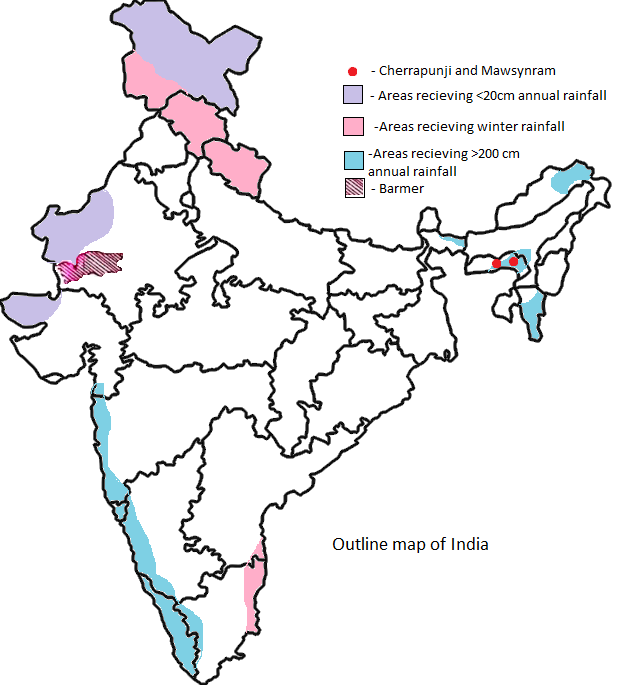
On the outline map of India, mark the following appropriately:
A) Areas receiving winter rainfall
B) Areas receiving less than 20 cm of annual rainfall
C) Areas receiving more than 200 cm of annual rainfall
D) Cherrapunji and Mawsynram
E) Barmer
Answer
553.2k+ views
Hint:
The vast geographical scale of India experiences a wide range of weather conditions. The monsoon occurs for four months called the summer monsoon begins by June and ends by September. The North East region of India experiences the summer monsoon at the most. The Northwest and Southwest parts experience the winter rainfall.
Complete Answer:
Pressure and temperature changes over the Arabian sea, the Indian Ocean, the Southern part of Pacific Ocean, and the Bay of Bengal plays an important role in monsoon rains over India. The major impact is contributed by the Thar Desert and the Himalayas.
The western disturbances cause off-monsoon rainfall which occurs from mid-October.
The Desert and Semi-desert regions of India receive less than 20 cm of annual rainfall. States of Rajasthan, Gujarat, and adjacent semi-desert areas are included under this category.
The regions that experience precipitation more that 200 cm are called Extreme precipitation regions. The Northeast regions and the windward side of Western Ghats are included in this category.
Mawsynram is a village situated in East Khasi Hills of Meghalaya. It is the region with the highest precipitation. India’s and World’s highest rainfall is recorded here. Chrrapunji is also a village located in East Khasi Hills of Meghalaya. It is referred to as the wettest place on Earth.
Barmer district located in Rajasthan forms a part of Thar Desert. It is one of the scanty rainfall regions.
Various regions of India experience different climatic conditions based on different geographical terms. Some of the regions get very high rainfall and others get very low rainfall. The precipitation in India is very irregular. The average rainfall in India is around 118 cm as per the annual data of Meteorological Department.

Note:
The lowest precipitation till now recorded in India is in Ruyli village of Rajasthan. The weather of India is diverse. The three main seasons of Indian subcontinent are summer, winter and monsoon. The monsoon begins by June and ends by September after which the post-monsoon activities take place.
The vast geographical scale of India experiences a wide range of weather conditions. The monsoon occurs for four months called the summer monsoon begins by June and ends by September. The North East region of India experiences the summer monsoon at the most. The Northwest and Southwest parts experience the winter rainfall.
Complete Answer:
Pressure and temperature changes over the Arabian sea, the Indian Ocean, the Southern part of Pacific Ocean, and the Bay of Bengal plays an important role in monsoon rains over India. The major impact is contributed by the Thar Desert and the Himalayas.
The western disturbances cause off-monsoon rainfall which occurs from mid-October.
The Desert and Semi-desert regions of India receive less than 20 cm of annual rainfall. States of Rajasthan, Gujarat, and adjacent semi-desert areas are included under this category.
The regions that experience precipitation more that 200 cm are called Extreme precipitation regions. The Northeast regions and the windward side of Western Ghats are included in this category.
Mawsynram is a village situated in East Khasi Hills of Meghalaya. It is the region with the highest precipitation. India’s and World’s highest rainfall is recorded here. Chrrapunji is also a village located in East Khasi Hills of Meghalaya. It is referred to as the wettest place on Earth.
Barmer district located in Rajasthan forms a part of Thar Desert. It is one of the scanty rainfall regions.
Various regions of India experience different climatic conditions based on different geographical terms. Some of the regions get very high rainfall and others get very low rainfall. The precipitation in India is very irregular. The average rainfall in India is around 118 cm as per the annual data of Meteorological Department.

Note:
The lowest precipitation till now recorded in India is in Ruyli village of Rajasthan. The weather of India is diverse. The three main seasons of Indian subcontinent are summer, winter and monsoon. The monsoon begins by June and ends by September after which the post-monsoon activities take place.
Recently Updated Pages
Two men on either side of the cliff 90m height observe class 10 maths CBSE

What happens to glucose which enters nephron along class 10 biology CBSE

Cutting of the Chinese melon means A The business and class 10 social science CBSE

Write a dialogue with at least ten utterances between class 10 english CBSE

Show an aquatic food chain using the following organisms class 10 biology CBSE

A circle is inscribed in an equilateral triangle and class 10 maths CBSE

Trending doubts
The shortest day of the year in India

Why is there a time difference of about 5 hours between class 10 social science CBSE

Write a letter to the principal requesting him to grant class 10 english CBSE

What is the median of the first 10 natural numbers class 10 maths CBSE

The Equation xxx + 2 is Satisfied when x is Equal to Class 10 Maths

What is the missing number in the sequence 259142027 class 10 maths CBSE




